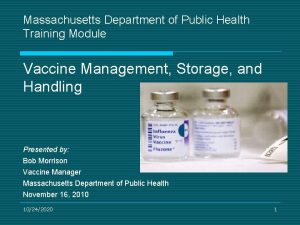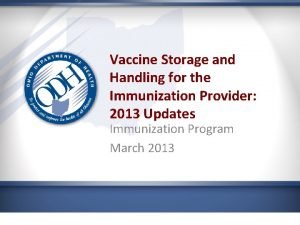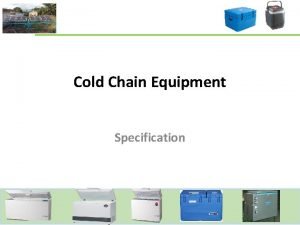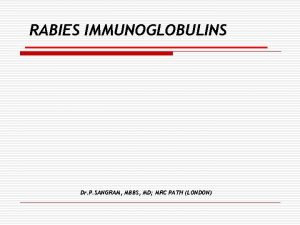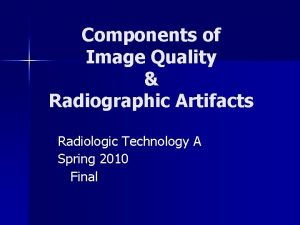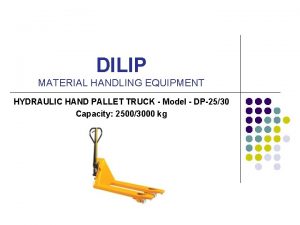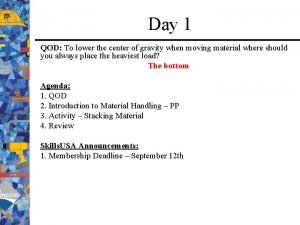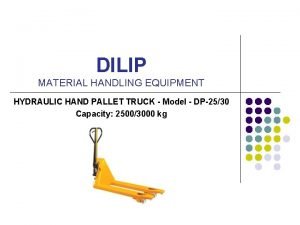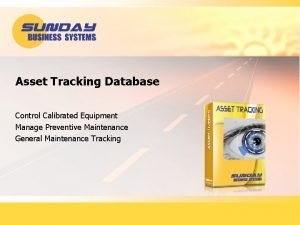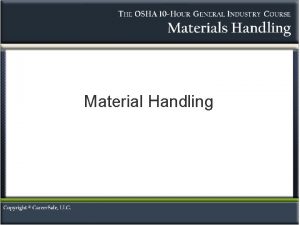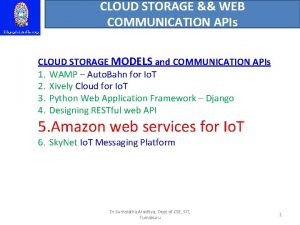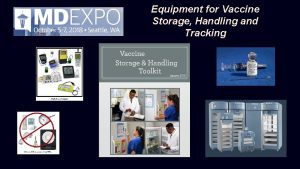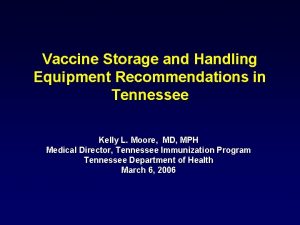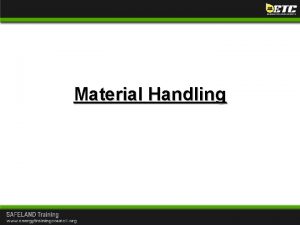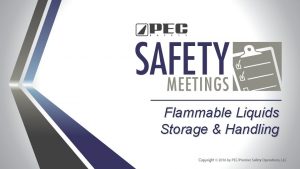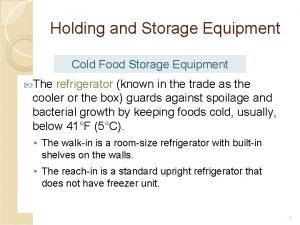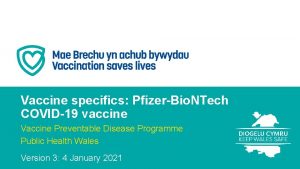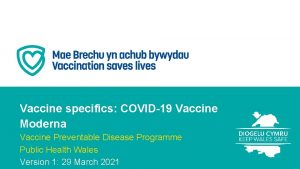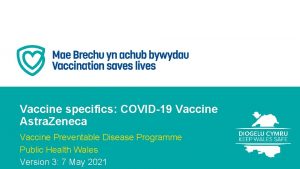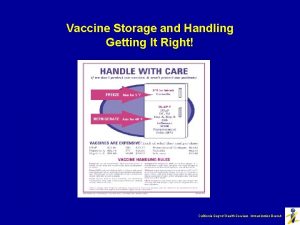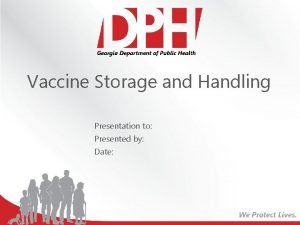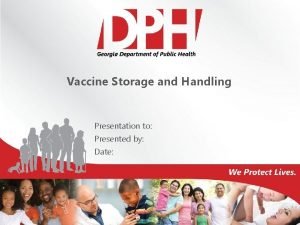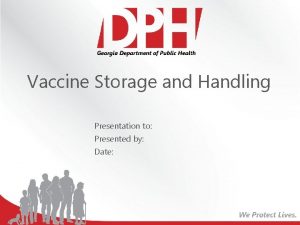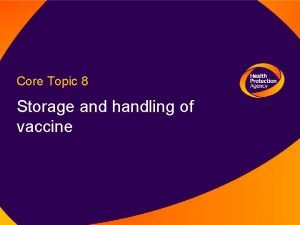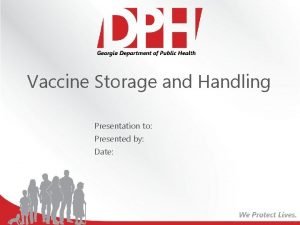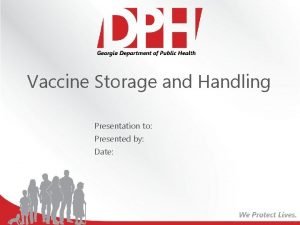Equipment for Vaccine Storage Handling and Tracking INTRODUCTION























- Slides: 23

Equipment for Vaccine Storage, Handling and Tracking

INTRODUCTION BENJAMIN K. ROBERTS MS, CBET • BACHELOR OF SCIENCE, ELECTRONIC ENGINEERING TECHNOLOGY OREGON TECH • MASTERS OF SCIENCE, APPLIED PHYSICSUNIVERSITY OREGON • LICENSED ELECTRICIAN, LIMITED ENERGY JOURNEYMANOR. • •

BENJAMIN K. ROBERTS MS, CBET CDC’S VACCINE STORAGE &HANDLING TOOLKIT JANUARY 2018 UPDATE HTTPS: //WWW. CDC. GOV/VACCINES/HCP/ADMIN/STORAGE/TOOLKIT/STORAGE-HANDLING-TOOLKIT. PDF WITH COMMENTS FROM THE WASHINGTON STATE HEALTH AUTHORITY VACCINE FOR CHILDREN PROGRAM • TEMPERATURE MONITORING DEVICES (TMD) • CALIBRATION &TESTING • VACCINE STORAGE EQUIPMENT • TRANSPORT &EMERGENCY SITUATIONS

TEMPERATURE MONITORING DEVICES (TMD) CDC recommends Digital Data Logger (DDLs) with the following features: • Detachable probe that best reflects vaccine temperatures (e. g. , a probe buffered with glycol, glass beads, sand, or Teflon®) • Alarm for out-of-range temperatures • Low-battery indicator • Current, Max & Min temperature display • Recommended uncertainty of +/-0. 5° C (+/-1° F) • Logging interval (or reading rate) no less frequently than every 30 minutes. • WSDo. H - Set data loggers to record temperatures every 6 to 15 minutes.

TEMPERATURE MONITORING DEVICES (TMD) Alternative Temperature Display Request Form (PDF) Federal requirements with regard to temperature monitoring systems have changed. ALL providers enrolled in the Childhood Vaccine Program must use a Digital Data Logger OR a Temperature Monitoring System. WSDo. H - The device must have continuous monitoring, recording capabilities, and a Digital display. Providers who own systems that do not have a display must apply for an exemption from Washington State Department of Health, Office of Immunization and Child Profile (OICP) by filling out and submitting this document. Once approved, the exemption must be kept in the facility’s vaccine management plan binder. https: //www. doh. wa. gov/Portals/1/Documents/Pubs/348 -654 -Alternative. Temp. Display. Request. Form. pdf

TEMPERATURE MONITORING DEVICES (TMD) CDC does NOT recommend the following TMDs: • • • Alcohol or mercury thermometers, Bi-metal stem TMDs Food TMDs Chart recorders Infrared TMDs that do not have a current and valid Certificate of Calibration Testing

TEMPERATURE MONITORING DEVICES (TMD) HOW MANY TMD’S SHOULD BE ON AT EACH LOCATION YOUR FACILITY SHOULD HAVE ATMD (PREFERABLY A DDL) FOR: • EACH VACCINE STORAGE UNIT • EACH EMERGENCY TRANSPORT UNIT • AT LEAST ONE BACKUP TMD

TEMPERATURE MONITORING DEVICES (TMD) TMD Placement To help ensure vaccines are stored at appropriate temperatures: • Place the DDL’s active digital display on the outside of the unit so temperatures can be checked without opening the door • Place the buffered probe of the DDL in the center of the unit with the vaccines surrounding it. • Pro tip: Avoid breaking door seal with probe wire if possible. Most purpose built units have built-in access ports.

TEMPERATURE MONITORING DEVICES (TMD) Monitoring Vaccine Temperature CDC recommends that providers: • Have a temperature monitoring log sheet placed on each storage unit door (or nearby). • Check and record storage unit minimum and maximum temperatures at the start of each workday. This is a requirement for VFC providers • WSDo. H requires the recording of BOTH min/max AND twice daily temps • Also check the current temperature each time vaccines are accessed in the storage unit. • Recommended best practice: Train staff to look for the high/low alarms at this time. WSDo. H Refrigerator Monitoring Log

TEMPERATURE MONITORING DEVICES (TMD) Monitoring Vaccine Temperature CDC recommends on a weekly basis: • Review storage unit temperature readings and review continuous DDL software or website information for changes in temperature trends that might require action • Recommended best practice: This also is the recommended interval for downloading non-Internet connected DDL devices. • File this information so it can be analyzed for long-term trends and/or recurring problems. Temperature data should be kept for 3 years

TEMPERATURE MONITORING DEVICES (TMD) Temperature Excursions (Out-of-Range Temperatures) Temperature excursions or inappropriate conditions for any vaccine require immediate action. Refrigerator Store Vaccines Between 2ºC and 8ºC (36ºF and 46ºF) (1. 7ºC and 7. 8ºC) Freezer Store Vaccines between -50ºC and -15ºC (-58ºF and +5ºF)

TEMPERATURE MONITORING DEVICES (TMD) Temperature Excursions (Out-of-Range Temperatures) If there is any question about whether vaccines may have been exposed to an out-of-range temperature because the unit became too cold or too hot, CDC recommends the following steps: 1. Ensure staff has notified the primary or alternate vaccine coordinator immediately and then report the problem to their supervisor and/or clinic manager. 2. Vaccine coordinator or designated staff should follow their protocols , label exposed vaccines, “DO NOT USE, ” and place them in a separate container apart from other vaccines in the storage unit. Often this is just labeling the unit itself as “DO NOT USE, ” 3. Direct staff to use their Standard Operating Procedure (So. P) for temperature excursions, which should include contacting the vaccine manufacturers, and the state, if under the Vaccine for Children program (VFC).

CALIBRATION & TESTING TMD Calibration testing should be done every 1 to 2 years, or according to the manufacturer’s suggested timeline. • Per WS Do. H : Alarmed electronic monitoring system must be tested a minimum of twice per year to ensure it is functioning properly. Keep records of the testing in the practice’s vaccine management plans. • CDC recommends that a DDL’s current and valid Certificate of Calibration Testing (Report of Calibration) should include: • Model/device name or number • Serial number • Date of Calibration (report or issue date) • Confirmation that the instrument passed testing (or instrument in tolerance) • Recommended uncertainty of +/-0. 5° C (+/-1° F) or less

CALIBRATION & TESTING TMD Also the Certificate of Calibration Testing or Report of Calibration should be issued by an appropriate entity. The certificate indicates one or more of the following: • Conforms to International Organization for Standardization (ISO)/International Electro-technical Commission (IEC) 17025 international standards for calibration testing and traceability • Performed by a laboratory accredited by International Laboratory Accreditation Cooperation (ILAC) Mutual Recognition Arrangement (MRA) signatory body – A list of ILAC/MRA signatories may be found at ILAC. org/ILAC-MRA-and-signatories/ • Traceable to the standards maintained by the National Institute of Standards and Technology (NIST) Pro Tip: There is a registered trademark Traceable® that is commonly misunderstood for this technical term. • Meets specifications and testing requirements for the American Society for Testing and Materials (ASTM) Standard E 2877 Tolerance Class F (< +/-0. 5° C or < +/-1° F) or better

VACCINE STORAGE TO FULLY ENSURE THE SAFETY OF VACCINES, THE FOLLOWING EQUIPMENT IS RECOMMENDED: • MAINTAINING THE CHAIN OF COLD. • REFRIGERATORS - THERMOSTAT SHOULD BE SET AT MIDRANGE TO ACHIEVE A TEMPERATURE OF ABOUT 5°C. • FREEZERS - THERMOSTAT SHOULD BE SET AT THE FACTORY-SET OR MIDPOINT TEMPERATURE TO ASSURE APPROPRIATE FROZEN STORAGE TEMPERATURES. • THERMOSTAT ADJUSTMENTS SHOULD ONLY BE MADE BY THE PRIMARY OR ALTERNATE VACCINE COORDINATOR, BASED ON INFORMATION FROM THE TMD AND TEMPERATURE MONITORING LOG. • POST A WARNING SIGN ON ALL STORAGE UNITS STATING, D “ O NOT ADJUST TEMPERATURE CONTROLS. NOTIFY (NAME OF VACCINE COORDINATOR) IF ADJUSTMENT IS NECESSARY. ” • USE SAFEGUARDS TO ENSURE THE DOORS OF THE UNIT REMAIN CLOSED (FOR EXAMPLE, SELF-CLOSING DOOR HINGES, DOOR ALARMS, DOOR LOCKS, ETC. ) • IF POSSIBLE, NO ITEMS OTHER THAN VACCINES, DILUENTS, AND WATER BOTTLES SHOULD BE PLACED OR STORED IN THE UNITS. • FOOD AND BEVERAGES SHOULDNEVER BE STORED IN THE UNIT WITH VACCINES. • WATER BOTTLES TO HELP MAINTAIN STABLE TEMPERATURES. LABEL ALL WATER BOTTLES, “DO NOT DRINK ” Freezer Store Vaccines between -50ºC and -15ºC (-58ºF and +5ºF) Refrigerator Store Vaccines Between 2ºC and 8ºC (36ºF and 46ºF) (1. 7ºC and 7. 8ºC) WSDo. H Data Logger Guidelines

VACCINE STORAGE Water bottles to help maintain stable temperatures. Place water bottles on the top shelf, drawers, floor and in the door racks. • Do not place vaccine under cooling vent; it can be 2°C to 5°C colder. If the top shelf must be used, only store MMR vaccines on this shelf. • Do not place vaccine in crisper drawers: fill floor space with water bottles. Can be 1°C to 2°C colder than main refrigerator space. Some refrigerator units, particularly pharmaceutical-grade units, may have specific guidance about the use of water bottles. Check the manufacturer’s guidance for your unit. Freezer Store Vaccines between -50ºC and -15ºC (-58ºF and +5ºF) Refrigerator Store Vaccines Between 2ºC and 8ºC (36ºF and 46ºF)

VACCINE STORAGE TO FULLY ENSURE THE SAFETY OF VACCINES, THE FOLLOWING EQUIPMENT IS RECOMMENDED: • STAND-ALONE REFRIGERATOR(S) / FREEZER(S) WITH ENOUGH SPACE TO ACCOMMODATE YOUR MAXIMUM INVENTORY WITHOUT CROWDING. • DO NOT PACK A STORAGE UNIT TOO TIGHTLYTHIS CAN RESTRICT AIR CIRCULATION AND IMPACT VACCINE TEMPERATURE. • CDC MAKES THE FOLLOWING RECOMMENDATIONS FOR VACCINE STORAGE UNITS: • USE PURPOSE-BUILT UNITS DESIGNED TO EITHER REFRIGERATE OR FREEZE (CAN BE COMPACT, UNDERTHE-COUNTER-STYLE OR LARGE UNITS). PURPOSE-BUILT UNITS ARE SOMETIMES REFERRED TO AS “PHARMACEUTICAL GRADE” AND ARE DESIGNED SPECIFICALLY FOR STORAGE OF BIOLOGICS.

VACCINE STORAGE When a Purpose-Built Unit is NOT Available. • If a purpose-built unit is not available, use a stand-alone household unit. • If you must use a household-grade, combination refrigerator/freezer unit, only use the refrigerator compartment for storing vaccines. • Do not store any vaccine in a dormitory-style or bar-style combined refrigerator/ freezer unit under any circumstances. • WSDo. H: New providers cannot use a combo unit. If replacing a combo unit, it must be a stand-alone unit. Pro Tip: With household & commercial grade units, manufacturer specifications are often designed to have broader temperature fluctuations than vaccine tolerances may allow.

VACCINE STORAGE Home Grade vs. Laboratory Grade Refrigerator Image Provided by Scott D. Olsen UWMC Operations & Maintenance

VACCINE STORAGE STABILIZING TEMPERATURES IN NEW AND REPAIRED NITS In U new or repaired units, it can take temperatures: • In Refrigerator, 2 to 7 days to stabilize. • In freezers, 2 to 3 days to stabilize. Once there are 2 consecutive days of temperatures recorded within the recommended range, the unit is stable and ready to be used.

VACCINE STORAGE Take the following precautions to protect the storage unit’s power supply: • Plug in only one storage unit per electrical outlet to avoid creating a fire hazard or triggering a safety switch that would turn off power. • Post “DO NOT UNPLUG” warning signs at outlets and on storage units to alert staff, custodians, electricians, and other workers not to unplug units. • Label fuses and circuit breakers to alert people not to turn off power to storage units. • Use a safety-lock plug or an outlet cover to prevent the unit from being unplugged.

TRANSPORT & EMERGENCY SITUATIONS • Never allow vaccines to remain in a nonfunctioning unit for an extended period of time. If you believe the unit has failed, begin to implement your emergency vaccine plan and SOPs. Transport and emergency situations also require special equipment. Appropriate materials include: • • Portable vaccine refrigerator/freezer units (recommended) Qualified containers and pack-outs Hard-sided insulated containers or Styrofoam Coolant materials: Frozen 16. 9 - or 8 -ounce water bottles that can be conditioned or 4° C to 5° C phase change materials (PCMs) • Insulating materials such as bubble wrap or corrugated cardboard, enough to form two layers per container • TMDs for each container Do not use soft-sided coolers Most commercially available soft-sided coolers are poorly insulated and likely to be affected by room or outdoor temperatures

QUESTIONS?
 Vaccine storage and handling sop worksheet
Vaccine storage and handling sop worksheet Vaccine storage and handling protocol
Vaccine storage and handling protocol Wic in cold chain
Wic in cold chain Rabies vaccine storage
Rabies vaccine storage Vaccine storage temperature chart
Vaccine storage temperature chart Safety
Safety Kink marks artifact
Kink marks artifact Dilip material handling equipments
Dilip material handling equipments Motorized material handling equipment
Motorized material handling equipment Dilip material handling equipment
Dilip material handling equipment Equipment tracking database
Equipment tracking database Primary storage vs secondary storage
Primary storage vs secondary storage Secondary storage vs primary storage
Secondary storage vs primary storage Uses rigid metallic platters
Uses rigid metallic platters Unified storage vs traditional storage
Unified storage vs traditional storage Introduction of material handling
Introduction of material handling Introduction to materials handling
Introduction to materials handling Nas vs san
Nas vs san Cloud storage models and communication apis in iot
Cloud storage models and communication apis in iot Introduction to san and nas storage
Introduction to san and nas storage Kontinuitetshantering
Kontinuitetshantering Novell typiska drag
Novell typiska drag Nationell inriktning för artificiell intelligens
Nationell inriktning för artificiell intelligens Vad står k.r.å.k.a.n för
Vad står k.r.å.k.a.n för
